Fungal nail infection is a common infection of the fingernails or toenails
Fungi are everywhere. Sometimes, they are too small to see with the naked eye but they are normally present in our body throughout our life.
However, anyone can be affected with fungal disease when fungus begins to overgrow.
Fungal nail infections are common infections of the fingernails or toenails. In this, the nail becomes discoloured, thick, and more likely to crack and break. Infections are more common in toenails than fingernails.
The medical name for a fungal nail infection is “onychomycosis.”
Table of Contents
What are the signs and symptoms of Fungal nail infection?
One should be watchful of the following symptoms that are can be commonly seen in fungal nail infections:
- Yellow, brown, or white spot or discolouration of your nails
- Thickened nail
- Fragile, or cracked
- Foul smell from the infected nail
- Distorted in shape
- Tunneling under the nail plate
- Fungal nail infection is usually painless unless it becomes severe
If the infection is mild and is not causing you any pain then you may not need treatment. However, if you start experiencing pain then self-hygiene and anti-fungal medications may help in treating it.
Fungal skin infection on the foot, especially between the toes is called “athlete’s foot” or tinea pedis.
What are the causative agents for fungal nail infection?
Many different types of fungi like yeast or molds that live in the environment can cause fungal nail infections. The germs can enter your nail through some small cracks or the surrounding skin and cause an infection.
What are the common types of nail fungus?
Distal and lateral subungual onychomycosis
It is the most common type of fungal nail infection and can develop in both fingernails and toenails. Nail plate and nail bed both are involved.
Outer edge of the nail appears to be jagged with white and/or yellow streaks across the nail.
Proximal subungual onychomycosis
It is an uncommon type but can affect both fingernails and toenails. It also affects both nail plate and nail bed
Yellow spots appear at the base of the nail from where the infection spreads upward
It is more common in people with weak immune system
Superficial white onychomycosis
Only the superficial part of the nail plate is involved, there is no nail bed involvement.
The nail may become rough, pitted, soft and prone to crumbling
It is more common in people with weak immune system
Totally dystrophic onychomycosis
In this type complete destruction of nail is seen
Candidal paronychia
Presents as redness, edema, and tenderness of the proximal nail folds.
Thickening and discoloration of the nail plate
Separation of proximal nail fold from the nail plate may occur

Who can get fungal nail infections?
Anyone can get a fungal nail infection. Some people are more likely than others to get a fungal nail infection including:
- Older adults or over age 65 because the nails thicken as we age and the nail growth slows down.
- A nail injury or nail surgery
- Moist fingers or toes for an extended time
- Those who have Diabetes
- A weakened immune system
- Blood circulation problems
- Athlete’s foot (ringworm on the foot) do spread from person to person among families and probably others sharing close quarters.
- Walking barefoot in damp areas
- Those who wear closed-toe shoes for longer duration leading to heavy sweating and moist environment.
Diagnosis of nail fungus
Your healthcare provider may diagnose a fungal nail infection by looking at the affected nail and asking questions about your symptoms. He or she may also take a nail clipping to look at under a microscope or send to a laboratory for a fungal culture.
Diagnosis can be made by visual inspection alone. However, laboratory tests may be needed.
- Microscopy: Potassium hydroxide (KOH) stain is a commonly-used method because it is inexpensive and easy to perform. Nail clippings or scrapings are placed in a drop of KOH and examined under a microscope for the presence of fungal elements. Periodic Acid-Schiff (PAS) staining can also be used.
- Culture: Fungal culture on Sabouraud’s medium or dermatophyte test medium (DTM) can be used to identify the infecting organism
How to treat nail fungal infection?
Fungal nail infections can be difficult to cure, and they typically don’t go away without antifungal treatment.
The best treatment for a fungal nail infection is usually prescription antifungal pills taken by mouth.
Oral terbinafine is considered to be the first-line treatment for confirmed onychomycosis; the treatment course is generally 6 weeks for fingernails and 12 weeks for toenails
Other medicines can be used like:
- Itraconazole
- Fluconazole
- Griseofulvin
Topical antifungal agents can be used but are often ineffective
In severe cases, a doctor might remove the nail completely.
Laser treatments for onychomycosis appear to be a promising
It can take several months to a year for the infection to go away.
How to prevent fungal nail infection?
Follow some simple lifestyle changes and good personal hygiene to prevent fungal nail infections:
- Keep your hands and feet clean and dry. Wash your hands and feet immediately after touching infected nails.
- Clip your fingernails and toenails short and keep them clean.
- Don’t walk barefoot in areas like locker rooms or public showers.
- Wear breathable socks that will absorb the moisture, keeping your feet cool and dry.
- Don’t share nail clippers with other people.
- When visiting a nail salon, choose a salon that is clean. Make sure the salon sterilizes its instruments (nail clippers, scissors, etc.) after each use, or, you can bring your own.
- Avoid using nail polish or use of artificial nails.
If you’re prone to excessive moisture around your fingernails or toenails, consider buying:
Manicure or pedicure set of your own
A Visual Learning Platform





